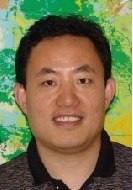Visiting Researchers
 |
Institute |
Geology & Geophysics at Texas A&M University |
Title |
Associate Professor | |
Country |
U.S.A. | |
Period of Stay |
2014/07/16 - 2014/11/15 | |
Research Theme |
Spontaneous rupture modeling of recent large earthquakes and dynamic-source based strong ground-motion simulations | |
Host Researcher |
Nobuki KAME |
My research interests generally fall in disciplines of geophysics and tectonophysics. Currently, my research focuses on earthquake source physics, particularly earthquake rupture dynamics of geometrically complex faults, including faults with bends, stepovers, and branches, and recent large earthquakes, including the 2011 Mw 9.0 Tohoku-Oki earthquake and the 2008 Mw 7.9 Wenchuan earthquake. I am also interested in applying dynamic source models to ground motion simulation and prediction for physics-based seismic hazard analysis. We’ve developed an explicit finite element method code (EQdyna) with hybrid MPI/OpenMP parallelization for dynamic rupture and seismic wave propagation simulations on high-performance computing systems.
During my visit at ERI, I plan to collaborate with colleagues at ERI and beyond who work on the 2011 Mw 9.0 Tohoku-Oki earthquake to investigate controls on dynamic rupture propagation of the event. We will build spontaneous rupture models of the earthquake, based upon available data of megathrust fault geometry, velocity structure, frictional properties, stress states, pore fluid pressure, etc. We will explore roles of complex (non-planar) fault geometry, heterogeneous frictional properties, and heterogeneous initial stresses along the megathrust fault in this earthquake’s dynamic rupture process. We will compare outputs of our dynamic models with near-field co-seismic recordings, including seismograms and GPS data, to validate our models. Improved understanding of controls on dynamic rupture propagation of the event from this planned work will allow the scientific community to better assess megathrust earthquake hazard along this subduction zone and other subduction zones worldwide. In addition, comparing synthetics from our dynamic models with strong ground-motion recordings from this earthquake may provide a valuable validation of an advocated methodology for ground motion prediction – using dynamic source characterization and high-performance computing.
